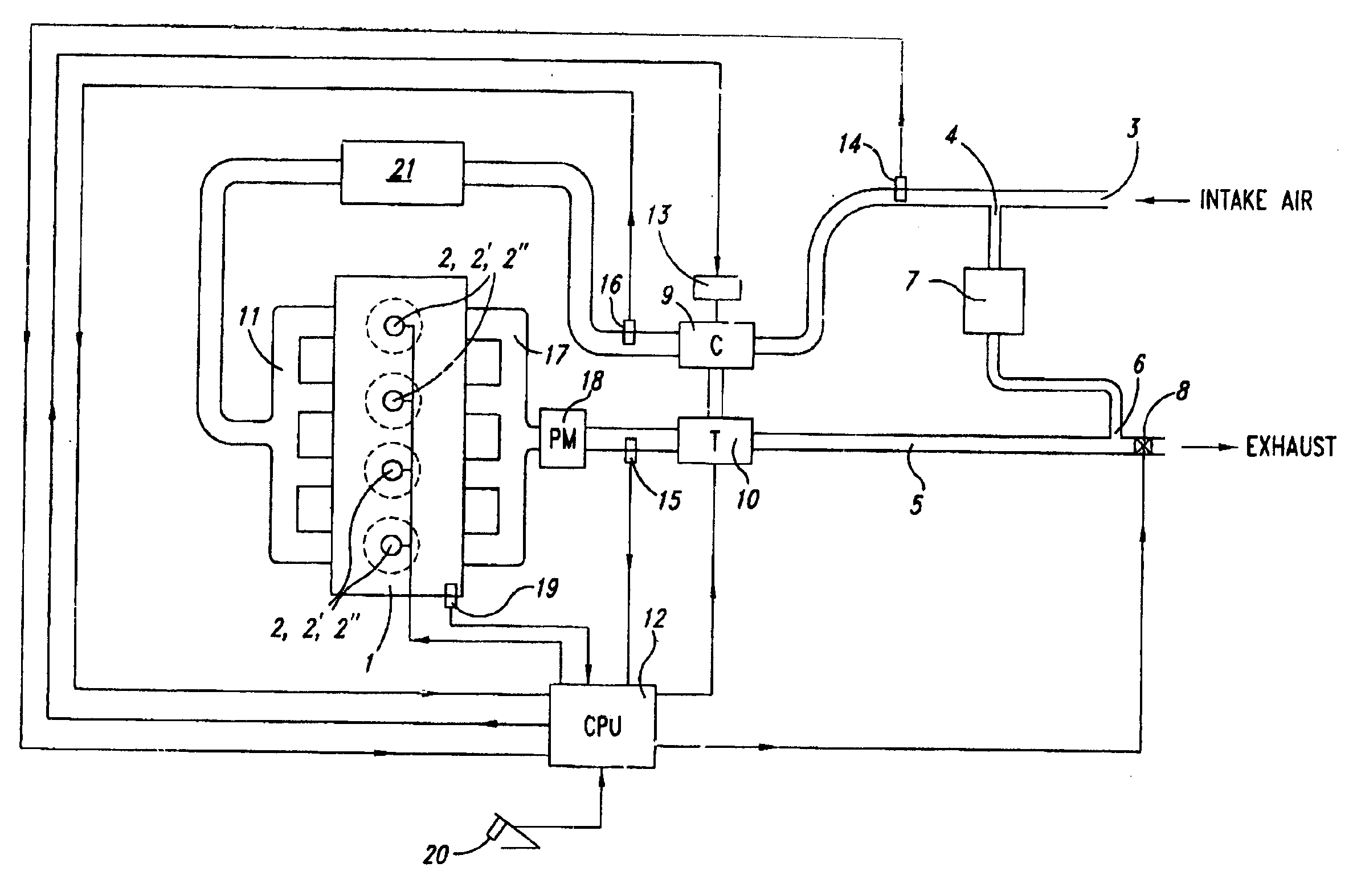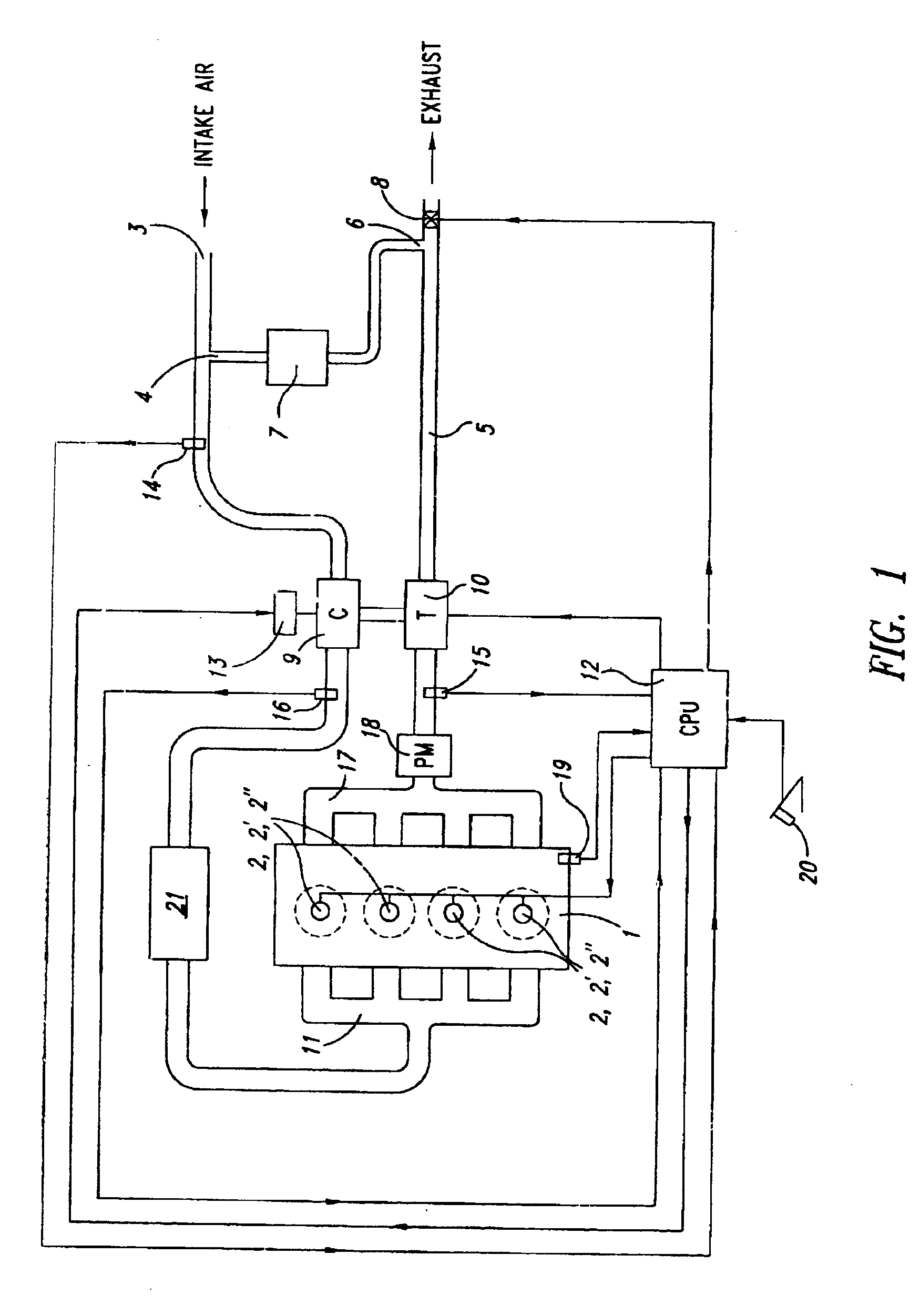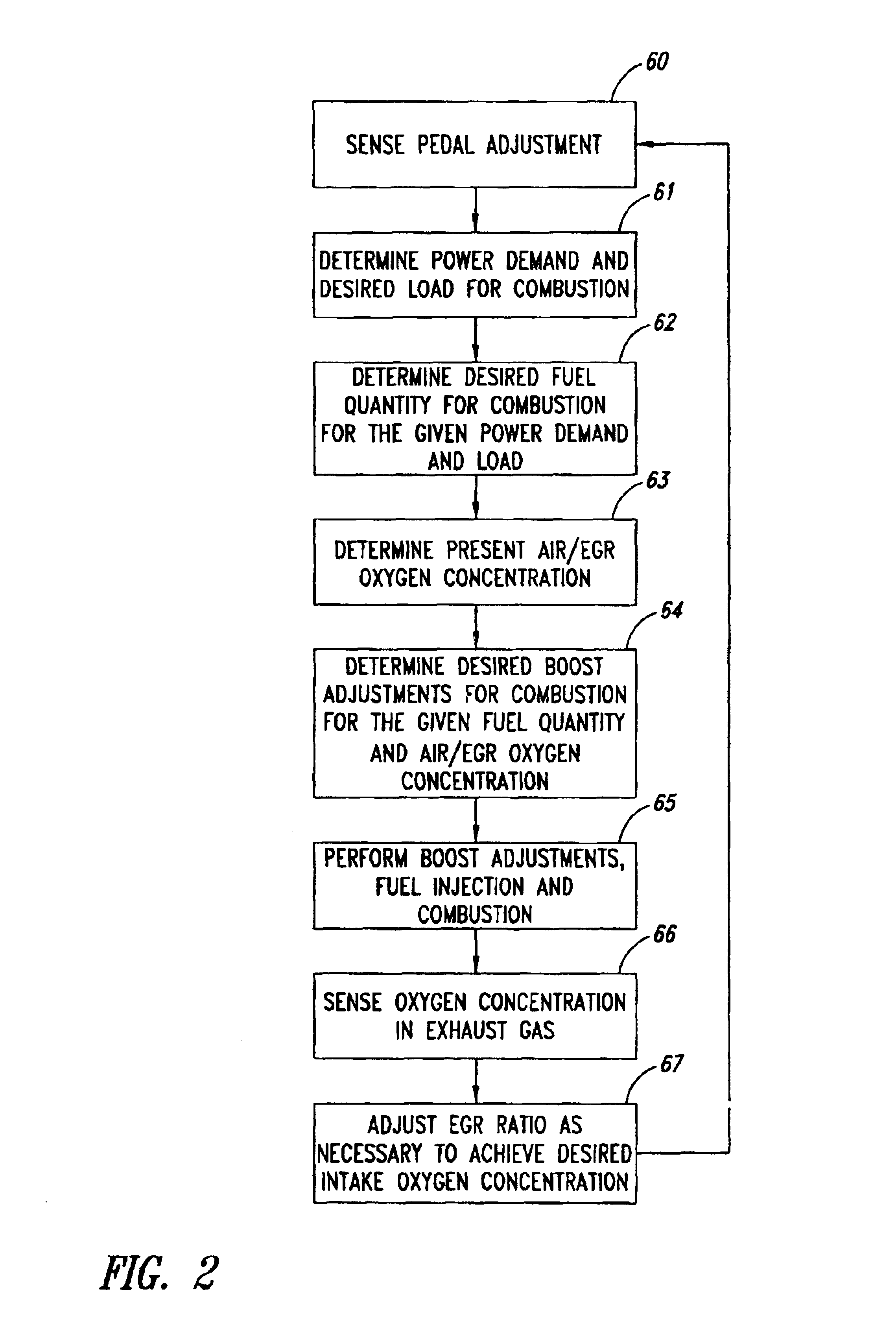This localized unit heat release dampening effect from low charge-air
oxygen concentration levels limits localized heat propagation, which would otherwise create pockets in combustion where localized peak combustion temperatures exceed NOx formation levels and result in the formation of NOx.
While the prior art recognizes that moderate levels of EGR will reduce NOx formation in diesel engines, most industry experts wrongly attribute NOx reduction with EGR usage to bulk effects from EGR usage—namely, an increase in the overall
heat capacity of the in-cylinder charge, which limits
bulk temperature increases in combustion, and thereby theoretically reduces overall NOx formation.
As a result of this misunderstanding of the primary NOx-reduction benefit from EGR usage for diesel engines, the prior art has not adequately developed the concept of more actively and directly controlling charge-air oxygen concentration levels as a means to reduce
diesel engine NOx emissions.
However, despite this awareness, EGR usage to reduce NOx formation has been heavily limited in the prior art by what may be referred to as the NOx-PM tradeoff.
The NOx-PM tradeoff has operated as an insurmountable roadblock in the prior art to the use of high levels of EGR for further NOx emission reductions in conventional diesel engines.
In part because of the NOx-PM tradeoff, various
diesel combustion experts have concluded that NOx emissions and PM emissions from diesel combustion physically cannot simultaneously both be controlled (engine-out, without aftertreatment) to environmentally acceptable levels, and that EGR levels above 25% at anything other than light or no load conditions in diesel engines will necessarily result in unacceptably poor engine performance and high particulate emission levels.
For example, one group of experts found that at EGR levels above 25% at relatively light loads or higher, even under purportedly optimal engine conditions, poor
engine efficiency and “excessively high levels of particulate, CO, and unburned hydrocarbons” result at levels that are “intolerable for a
diesel engine.” Patrick F. Flynn, et al, Minimum Engine
Flame Temperature Impacts on Diesel and Spark-Ignition Engine NOx Production, SAE Technical Paper 2000-01-1177, at 97-98.
Thus EGR levels beyond that amount would logically reduce combustion temperatures below the minimum
flame temperature, and prevent reasonable combustion in a
diesel engine.
These studies have found that oxygen concentrations below 16-17% significantly impede the ability for combustion to be maintained, and that
hydrocarbon fuels become completely
inert in environments with oxygen concentration levels lowered to around 12-13% at standard
temperature and pressure.
As a result of studies such as the Flynn report, and because of prior art failures to avoid the effects of the NOx-PM tradeoff and intolerably poor combustion in conventional diesel combustion with high EGR ratios, EGR usage has been capped in the prior art for diesel combustion systems, and high levels of EGR (and correspondingly low charge-air oxygen concentrations) have not been successfully utilized in commercial diesel engines at other than
light load or no load conditions.
This reference speculated that higher
fuel injection pressures may lower PM formation by providing a “higher injected
momentum [which] results in faster fuel-air mixing, which results in a shorter heat release duration and higher peak cylinder pressures.”
Despite this awareness that high
fuel injection pressures may lead to benefits in lowering
smoke formation in diesel emissions (with the traditional tradeoff of some corresponding increase in formation of NOx due to more vigorous combustion), fuel
injector technology thus far has failed to provide commercially available fuel injectors utilizing injection pressures above about 30,000 psi (2,063 bar).
These reasons include leakage problems, cost, durability, undesirable losses in
engine efficiency, undesirable increases in NOx formation, and discouraging results and predictions as to the ability of ultrahigh fuel injection pressures to result in continuing reductions in
smoke formation in combustion.
The combination of these factors results in an adverse cost / benefit balance that has previously militated against efforts to develop such fuel injection systems.
Use of ultrahigh fuel injection pressures necessarily entails addressing issues as to increased potential for leaks,
engine efficiency losses due to leaks and the higher pressures needed to be maintained, increased costs in developing such a system, and in
cracking and wear issues that could result from trying to use such high fuel injection pressures.
The prior art has not seen any significant benefits to increasing fuel injection pressures above state of the art high injection pressures of around 1800 bar.
Thus, following Flynn's prediction, ultrahigh pressure fuel injectors would be of no benefit, as they cannot enable rapid combustion or acceptable efficiency in a conventional diesel engine together with NOx-formation levels below about 1.0-1.5 g / bhp-hr, such as is performed in applicant's Controlled Temperature
Combustion method of combustion disclosed in the parent application hereof (i.e.
patent application Ser. No. 10 / 241,229, filed Aug. 8, 2002).
It further typifies the uncompromising belief in the prior art that acceptable diesel combustion cannot be obtained at the high EGR levels, low charge-air oxygen concentration levels, and / or low peak combustion temperatures utilized in
low temperature combustion efforts.
As a result, the Wickman injectors produced only mixed results at best, often resulting in higher PM and / or NOx levels than obtained with conventional fuel injection systems.
This disappointing result also stemmed in part from the design of the fuel injectors, which were
cam-driven and dependent on high engine speeds and loads.
In other words, the Wickman injectors were incapable of producing ultrahigh fuel injection pressures except at high speeds and loads, and therefore generally did not produce improved emissions results except at those particular speeds and loads.
However, the Perr '247 patent does not present any emissions-reduction benefits obtained with the invention, and does not discuss potential use of such injectors with high EGR levels, low charge-air oxygen concentration levels, and / or low peak combustion temperatures.
In addition, like the Wickman injectors, the Perr '247 injection system only reaches its high injection pressures at very high engine speeds (5,000 rpm), and is unable to provide high injection pressures at moderate or low engine speeds.
As such, the Perr '247 fuel injection system would be ineffective in significantly reducing PM formation across an entire engine operating map.
Finally, neither the Wickman injectors nor the Perr '247
injector appear to have been developed as a product, perhaps therefore reflecting conventional industry opinion (and that of fuel injection designers) that obtaining fuel injection pressures above state of the art levels provides no additional significant emissions-reduction benefits and does not justify the additional expense of production of such units on a cost /
benefit analysis basis.
 Login to View More
Login to View More 


